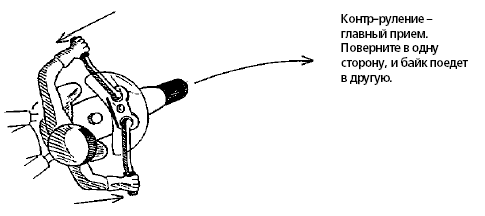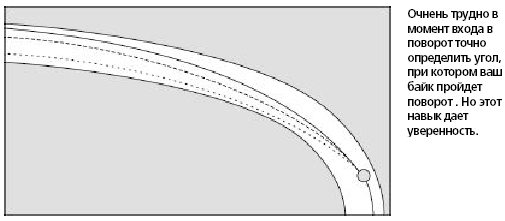|
The Chapter 12. Taxiing - to tame forces
As far as your taxiing can be precise? What forces act on a motorcycle
during taxiing? How them to tame? As far as it is fast necessary to turn
bike? What descends actually, when you turn? What limitations at taxiing?
How the taxiing influences control of gas? What SPI's work and from what?
Than they can to you do much harm? That is necessary and what it is not
necessary to do at taxiing?
Scale of skills
You can define skill of the driver therefore, what turns, taxis, tilts,
fills up (call somehow) bike. In turn with all evidence the skill of the
driver shows. Let's at first consider a fundamentals.
Fundamentals of taxiing
Each of us dropped from a bicycle, when studied as a men to go. Remember?
Auxiliary caster wheels as soon as were cleaned, you dropped. If you did not
have such caster wheels, you dropped from the very beginning. Well certainly.
You see near to you there was no person aware about contra-taxiing, and even
if he and was, how to explain, what is it such to the person never ranging
up to it an one-track transport means.
Contr-taxiing. Two magic words. Contr: fissile counteraction, contrast,
opposition. Taxiing: gang of a current of traffic. Receives, the
contr-taxiing is gang of a current of traffic by an inverse mode. All is
simple. You go directly and decide to turn, say, to the right. For this
purpose you turn a control surface on the left. Bike goes to the right.
Unfamiliar forces
Mahler who is off-the shelf to accept such method at once. Almost all in
it to a pattern works to the contrary pull or push something to the right
and it goes to the right, it is necessary to the left thrust to the left.

But which one are not subject to you two examples of things, this rule
the gyro and rotated bicycle sprocket, if it to hold for an axis. In both
cases your attempts to change a rule of torsion bodies will be finished is
unpredictable. Because a gyroscopic effect here is involved. The motorcycle
has two large rotated parts creating this effect - back and forward
sprockets. The gyro hardly resists to attempts to change a rule of the axis.
And you see it we also do, when we turn bike.
Taming of the gyro
The motorcycle in motion is stable enough. Than faster you go, the more
difficult is to turn. That counterforce, which one you feel, attempting to
turn a bicycle sprocket, is transmitted to the cradle and on the forward
fork, turning a forward sprocket and tilting bike.
The more angle of lean of the fork, the is more lighter to turn and to
tilt bike. Besides the spot of a contact of a forward sprocket is closer to
a center of mass, that also easies taxiing. The angle of lean of the forward
fork is one of main specifications influential in a controllability.

For dot visions of the driver the gyroscopic effect has simple sense: if
driving bike to not tamper with - he is stable, if it to attempt to turn he
potentially is astable. The best example of such instability - tripping-over
on a knoll in turn. Bike starts to yaw. The same knoll at rectilinear motion
would not influence in any way stability.
Taxiing and on control of gas
Exists much SPI's, working at taxiing. The drivers, as a rule, do not
want to open gas, yet will not finish taxiing and will not be convinced,
that their pathway conducts to escaping turn, instead of on a shoulder. I
bodily disjoint this stand, and bike - no, him need gas. But majority of the
racers do not turn off the handle, yet there will not pass approximately two
thirds of turn. So do everything, specially on a unfamiliar road. To tell
the truth, I do not see other solution, except for how to overcome myself
and nevertheless to open gas. Here, the truth, floats up one more aspect: in
such situation the driver can not precisely forecast, where exactly on a
road will appear bike as a result of executed taxiing.

There are also other important points. The infrequent driver starts to
taxi:
- In an exact place
- Is fast enough
- There is enough tilting bike.
Your rule on a road - outcome of exact fulfillment of all three points.
In following five chapters we shall learn to tame forces arising at
taxiing.
As general for all the ideal does not exist, if you are familiar with the
theory, know bike and know, what exactly you from it want, you can reach
your own ideal. He will be miscellaneous for tourer and sport bike. Being the
instructor in Superbike School, I often saw the schoolboys, which one turn
to pass an apex, purely overlooking about escaping turn. But you see the
apex is simple a stage on paths to an output. The taxiing is executed for
the subsequent acceleration Turn to anneal! DG
|